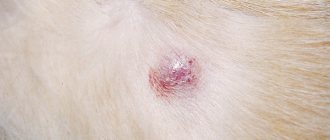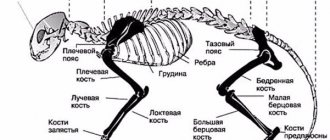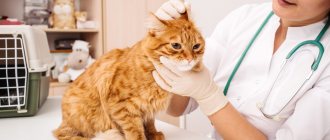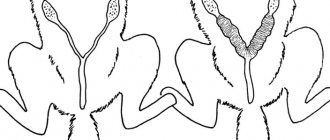Causes of fistula in cats
A fistula can form in a cat after surgery.
According to their origin, fistulas are divided into:
- acquired, appeared in the process of life;
- congenital - formed as a result of a violation of intrauterine development.
The fistula canal of a congenital fistula is lined with normal and healthy mucous cells, while secretions from the internal environment of the body are released from the fistula opening. The nature of the discharge depends on the location of the through hole itself, for example, it could be urine, saliva, bile, feces, etc.
Acquired fistulas are formed as a result of:
- penetrating or through wounds - in this case, wounds can appear both due to external influences (wound with a piercing object, gunshot wound) and as a result of tissue damage in the internal environment of the body; for example, in case of a bone fracture, when part of the fragment cuts through the skin from the inside;
- unintentional tissue damage during surgery;
- development of a purulent inflammatory process with necrosis of surrounding tissues in the deep layers of the skin; A striking example is a fistula in the oral cavity as a result of inflammation of the dental canal due to advanced caries or periodontal disease.
In addition, fistulas can appear due to improper, prolonged treatment of an abscess, boil and other skin diseases.
Varieties of the disease
Fistulas have several varieties depending on the following factors:
- localization locations;
- the reasons that caused the pathology.
Depending on the location and the fluid released
- Purulent fistulas are a means of draining pus from the source of the inflammatory process located deep inside.
- Urinary fistulas occur on the organs of the genitourinary system (ureter, bladder, urethra). The cause is most often injury.
- Intestinal - affects the upper part of the small intestine and appears as a result of intestinal obstruction, injury or unsuccessful surgery.
- Fistulas in the large intestine are localized in the lower abdomen. They drain feces and occur after injury or surgery.
- Biliary fistulas allow the passage of bile after unsuccessful surgery or as a result of injury. This is a very traumatic type of fistula, since the surrounding tissues are constantly inflamed as a result of contact with its aggressive contents.
- Salivary fluid is the result of inflammatory processes in the area of the roots of the teeth, ears, and cheeks.
Depending on the cause
According to their origin, fistulas are divided into two types:
- congenital (arise as a result of some defects in intrauterine development);
- acquired (arise as a result of injuries, complications after surgery, and various purulent processes).
Congenital fistulas
A congenital fistula is a straight or curved canal, lined from the inside with healthy epithelial tissue, through which there is an outflow of various biological fluids (saliva, urine, feces), depending on which organ is affected.
Presumable causes of the appearance of congenital fistulas are some kind of developmental disorders of the fetus, intrauterine infections when the mother’s immunity decreases while carrying kittens.
Congenital fistulas can be localized on the nose, neck, navel and other places. The most common is the so-called umbilical duct. This is a canal that connects a newborn baby's navel with his abdominal cavity. This type of fistula in itself is not dangerous. But the kitten can get sick, since the canal becomes a gateway for pathological microflora to enter.
Acquired fistulas
An acquired or pathological fistula is a canal lined with hyperemic granulation tissue. It can be the result of injuries (penetrating wounds and open fractures), complications after operations and advanced purulent processes:
- A fistula resulting from a penetrating wound is caused by a deep infected wound.
- A fistula that occurs as a result of tissue damage from bone fragments during treatment of a fracture will gradually close on its own.
- A fistula as a result of a complication of surgical interventions indicates that during the operation or suturing the rules of asepsis and antisepsis were violated, which led to tissue infection and inflammation.
- Advanced purulent processes. Their causes are unsuccessful attempts to cure abscesses or other inflammatory diseases at home. The progression of the process led to a large accumulation of purulent masses seeking outflow.
A dangerous type of fistula in cats is a fecal fistula in the large intestine. It may appear after sterilization or castration of animals carried out in violation. Its contents are feces, which creates a high risk of infection of surrounding tissues and, ultimately, can lead to purulent peritonitis and death.
Prevention measures
Prevention of fistulas involves regular medical examination of animals. After all, a disease noticed in time has every chance of being cured. In case of injury and fractures, care must be taken to ensure that the wounds heal completely and that the fractures heal without complications.
It is necessary to take measures to ensure that the cat’s body resistance is at a high level. This is facilitated by high-quality cat food, enriched with vitamins and microelements, a calm environment, active games, and timely control of parasites. After all, a strong immune system is a reliable protection against many ailments and unpleasant complications.
Preventive measures
The owner of the animal should be attentive to the health of his pet. The cat needs regular medical examination. After all, it is easier to cure the disease in the early stages. And in the case of fractures or other injuries, it is necessary to monitor how the bones and tissues grow together.
It is important to keep your cat's immunity high. And in this process, high-quality food rich in vitamins and microelements plays a far from secondary role. The animal also needs an active lifestyle and a comfortable environment. Then the cat’s immunity will protect the four-legged animal from many diseases.
In order to avoid the formation of a paraanal fistula in cats, it is important to monitor the condition of the paraanal glands. Sometimes they become inflamed. As a rule, domestic cats that lead a sedentary lifestyle are susceptible to pathology. They develop stagnation of secretion in the paired glands located near the anus. Normally, the contents are released during bowel movements. To prevent inflammation, you should periodically clean the glands, freeing them from accumulated secretions. You can also contact a veterinarian for this purpose.
If the animal has been sterilized, postoperative sutures should be carefully processed.
Treatment of fistula in a cat
It is impossible to cure a fistula, even with the help of the best and most expensive healing ointments. The only way to save your pet from suffering is surgery. It is carried out in several stages. Firstly, it is necessary to eliminate the source of inflammation, which is located deep in the tissues or organs of the animal. All dead tissue and foreign elements are removed.
Fistula in a cat can only be cured surgically.
Important. Such an operation should be carried out under completely sterile conditions so as not to introduce a new infection into the wound.
Next, for better outflow of purulent or fecal fluids, an additional drainage channel is made or a rubber tourniquet is inserted into the cleaned fistula. All granulation formations are removed from the fistula canal using a special spoon with sharp edges. After this, the fistula cavity is washed with some disinfectant (vodka, potassium permanganate or chlorhexidine).
Various healing ointments (Levomekol, Vishnevsky ointment, Dioxidin, etc.) are introduced into the canal treated in this way. Often a specialist will prescribe a course of antibiotic injections. After the source of inflammation is removed and the release of pathological fluids from the canal stops, the entire upper layer is cut out and the hole itself is sutured.
It is clear that you cannot cure such a disease on your own, at home. Only a highly qualified specialist can perform an operation and prescribe anti-inflammatory and restorative therapy.
Pathology therapy
If a diagnosis is made, treatment for fistula in cats should begin as quickly as possible. In this case, various methods are used:
- Cleaning the canal of foreign objects that caused inflammation, removing dead tissue, sanitizing the cavity. This is performed surgically under anesthesia. After the operation, the canal is treated with antiseptic agents daily until it is completely healed.
- Restoring the natural outflow pathway of physiological fluid or creating a drainage hole. The pathological canal is cleaned and sutured.
- Removal of affected tissue in the fistula using a surgical spoon. This method is used if there is no longer inflammation, but the fistula has not yet healed. For a pathological canal to become overgrown, it must be clean.
- Injection into the fistula canal of drugs that stimulate tissue healing. This is especially true if the cause of the fistula is injury. Often in such a situation, the body simply does not have enough strength to heal. Owners of older animals or cats weakened by chronic diseases encounter a similar phenomenon.
- Suturing the canal. This method is used if the fistula is congenital and covered with healthy epithelial tissue. The existing inflammation is treated, the epithelial layer is removed and the tissue is sutured.
At the same time, the animal is prescribed painkillers and, if necessary, infusion therapy.
There are times when doctors decide not to touch the fistula. For example, if anesthesia is contraindicated for the animal, or the cat is elderly, or suffers from cancer. Then the fistula is treated daily and the pet’s condition is monitored. The veterinarian will tell you exactly how to do this.
Along with treatment of the pathological area itself, antibacterial and immunocorrective drugs are also prescribed. How to treat a fistula in a cat is now clear, but the disease is always easier to prevent.
Fistula in a cat: types and treatment
The insidiousness of many diseases of our domestic animals is that their external manifestations are not visible in all cases. Of course, the cat may have a decreased appetite, he may be lethargic and apathetic, but most often one can only guess about the reason for such changes. So a fistula in a cat is an unpleasant phenomenon, but it is a more or less pronounced symptom, by which one can already judge the primary disease (and prescribe therapy).
What it is
In medical terminology, the disease is called a kind of channel that connects the animal’s skin to the body. If you look at it externally, the wound is very similar to an open abscess: a large hole where pus mixed with blood constantly oozes. The smell is the same characteristic as with an abscess.
A cat may develop a disease in the following cases:
- Innately. In this case, the problem arises even during intrauterine development, for example, when the mother had a hole in the navel, which connected the fetus to the abdominal cavity.
- Acquired. The disease may appear, for example, after surgery. So, this will indicate that the doctor did not comply with all antiseptic safety measures for the animal. The disease may also appear after improper treatment of the animal by the owners.
This disease does not pose any threat to life, but you should be wary of the fact that dangerous microorganisms can penetrate through the formed channel. Cats in which the disease has occurred near the anus should be under special supervision, since there is a high probability of contracting sepsis and other more serious diseases.
fistula in a cat
The disease in a cat can be classified into different forms. So, depending on how the canal walls are formulated, the disease can be divided into the following types:
- epithelized. In this case, the channel is even and smooth. Hair may constantly fall out around the wound, which indicates skin irritation;
Epithelized fistula in a cat
granulation. For this type, the characteristic loose walls and edges will have an irregular shape that extend beyond the wound itself.
You can also make a classification by location:
- Perianal fistula in a cat. It is considered the most dangerous type of disease, since the animal will have an abscess under its tail. The danger is that this type of disease can often develop into fecal peritonitis.
- Purulent. The location of this disease usually occurs on the cheek, paw, chin and other places. This type of disease is also called simple, since there are no major consequences from it.
And, of course, you can distinguish them based on the reasons for their occurrence. So, if this is a congenital disease, which is very rare, then the cause is intrauterine problems in the cat.
If this is an acquired fistula, then the reasons for its occurrence may be the following factors:
- wounds (penetrating or through);
- tissue damage during surgery, for example, a fistula after sterilization of a cat;
- complications of the purulent and inflammatory process, for example, when a disease appears in the oral cavity, it can appear through inflammation of the dental canal.
It will be difficult to independently determine the type and cause of your pet’s illness, so it is best to contact a veterinary clinic for diagnosis and treatment of the disease.
Diagnosis of the disease
If you suspect that your pet has a fistula, the owner should contact a veterinarian as soon as possible, without waiting for complications. The doctor takes the following diagnostic measures:
- external examination, collection of anamnestic data;
- magnetic resonance or ultrasound examination of the affected area;
- blood chemistry;
- identification of concomitant diseases;
- When the fistula is localized on the back, there is usually a suspicion of a malignant tumor. In this case, a biopsy is prescribed.
What is a fistula in cats
What is a fistula in a cat, how to treat it and recognize it? In veterinary medicine, it belongs to the category of surgical diseases and is referred to as a pathological phenomenon. It is a small open channel or depression that is formed between the inner and outer surfaces of the body or organ. Outwardly, this phenomenon is very unpleasant and resembles an open abscess from which pus or ichor oozes. Read about lichen in cats here.
Congenital fistula is the result of an intrauterine disorder that is difficult to prevent. In this case, an umbilical fistula often occurs, which, in principle, does not pose any particular danger in itself.
However, any open channel is a path for the penetration of pathogenic microflora. And here sepsis and other dangerous processes can already arise. But still, most of the occurrence of such pathological phenomena is acquired.
Causes
The most common cause of acquired fistula is neglected treatment of skin ailments. For example, improper treatment over time forms a fistula at the site of boils, abscesses or other dermatological problems.
Also quite common causes are various types of injuries and injuries to animals. Moreover, as practice shows, most often a fistula in a cat occurs inside the body, for example, on the inner mucous membrane of the mouth.
This also includes bone fractures that injure the skin from the inside, or any tissue damage during surgery. Maine Coon photo gallery see here.
Fistula formation on the abdomen
There is another special type of fistula in cats called fecal fistula. It is a kind of channel coming out of the large intestine. Such a channel can be a container for the contents of both the intestine itself and microorganisms from the external environment. It is often formed as a result of improper sterilization, internal tumors or severe injuries.
It is worth noting that this type of fistula is very dangerous, as it soon leads to fecal peritonitis. And this is fatal in all cases.
Symptoms of the disease
External fistula has more external symptoms than those associated with the behavior or internal state of the pet. Of course, it bothers the cat or cat and causes them inconvenience.
Internal fistulas are not immediately noticeable, but are more dangerous. This is because they are often noticed late and lead to more difficult and sometimes even incurable diseases. Here everything depends on its location and degree of development, therefore, as we see, there are no unambiguous signs.
At the initial stage, it is quite difficult to recognize an external fistula, since its surface resembles ordinary inflammation of soft tissues or a purulent wound. Therefore, cat owners often self-medicate their pets, not realizing how dangerous it can be.
However, the most characteristic feature of this disease is a constant wet state. This is due to the fact that liquid in the form of ichor or pus constantly flows through the fistula. Even after long-term therapy and drying, unlike a regular wound or an open abscess, the healing result is hardly noticeable.
Fistulas can also be recognized by their walls. For example, a distinction is made between epithelialized and granulation. The walls of the latter have a looser structure, resembling the image of a rose. Epithelialized fistulas have a smooth edge and a smooth and shiny surface. There is usually no inflammation around them, but dried crusts of discharge, as well as baldness, are observed.
Description
A fistula, or fistula, is a narrow canal whose walls are lined with granulation or epithelial tissue. In most cases, one side of the fistula comes to the surface of the skin, and pet owners often confuse it with an open abscess. Improper treatment of the pathology can cause the development of sepsis and the death of the cat.
An external fistula in a cat looks like a deep funnel with hyperemic edges. A wound that does not heal constantly oozes and has an unpleasant odor.
An internal fistula is formed due to inflammatory processes in the internal organs. It is usually detected in late stages, which significantly complicates treatment.
Depending on the location, the following types of fistulas are distinguished:
- Saliva - located on the cheek. Formed as a result of an inflammatory process on the teeth, salivary glands, and cheeks. Salivary fistulas do not threaten the life of the animal and are easy to treat.
- Intestinal - the cause of its development is trauma, unsuccessful surgery, cancer, unsuccessful surgery.
- Urinary - located in the area of the ureter, bladder. Formed due to organ damage.
- Gall - appear when the gallbladder is injured. Bile oozes through such fistulas; they are more difficult to treat than others.
- Paraanal - such a fistula is formed in a cat under the tail, in the area of the paraanal glands. The cause of its appearance may be a long-term inflammatory process.
- Purulent - formed as a result of the development of a purulent process. Most often it appears on the paws when they are damaged.
Depending on the structure, fistulas are:
- Granulation - characterized by uneven, loose walls of the canal that extends beyond the wound.
- Epithelialized - the canal has a smooth surface, there is no hair around it.
- Labial - there is an opening on the skin of the animal without a channel.
Abscess in cats. Treatment at home
There are different situations in life. And no one can exclude the possibility that the cat owner will not have the opportunity to come to the veterinary clinic and place his pet in the hands of professionals. If such a situation occurs, then it is necessary to carry out treatment yourself. You should be prepared to lance the abscess. The main thing is not to worry and consistently carry out all the steps to treat the animal.
- First of all, you should determine at what stage the disease is. If it is possible to identify an abscess at the initial stage, then warm compresses should be applied. Warming up the localization of the purulent process will accelerate its maturation. If the pet's condition is lethargic, it means that he is worried about pain. To relieve pain, you can inject Novocain.
- If the abscess is at a more serious stage and is severely inflamed, then heating cannot be done. What to do? When the abscess is at a more advanced stage, an incision must be made. This procedure should be done without fail, since the pus may begin to spread to other tissues if it is not released.
- To make an incision, you need to take a sterile needle, razor or scalpel. If the abscess is small, then a needle will do. For large ones you need to use a razor or scalpel. The procedure should be carried out with gloves. You will also need gauze pads, hydrogen peroxide, manganese and antibiotics.
- You should think about how to keep your cat stationary. To do this, you need to ask for help or figure out in advance how to hold the animal while making the cut.
- Before proceeding to the incision, you need to perform local anesthesia using the drug Novocaine or Lidocaine. The abscess site should be punctured. Next, you need to give time for the painkiller to take effect, about 10 minutes.
- Next, you should make an incision, allow the fluid to drain from the wound and treat it with antibiotics.
- Then you need to monitor the wound so that it does not heal prematurely and treat it with antibiotics. The bandage should be loose.
If the incision is small, the abscess should go away in a couple of weeks.
Paraanal glands in dogs: problems and solutions
This behavior is mistakenly taken for helminthiasis. 4. In advanced cases, hair falls out completely at the base of the tail root , and subsequently purulent fistulas open. When an animal tries to empty the glands to no avail, a pyogenic microflora develops in their cavity - pus is formed, which melts nearby tissues and comes out.
Prevention measures As we said at the beginning of the article, the blame for this disease lies with the owner because the glands need to be cleaned regularly. This procedure can be performed independently in several ways.
First method: Let's call it internal. Before the procedure, we put on medical gloves, lubricate the index finger with lubricant (vaseline, baby cream) and insert it into the rectum. We feel for one sinus and pinch it between the index, thumb and middle fingers. That is, the index finger is on the inside, and the other two help it by pressing on the outside through the skin. With the other hand we fix the dog, holding it by the root of the tail. We proceed in the same way with the second sine.
Second method: External, this method is more suitable for small breed dogs. When using it, we also put on a glove, but do not insert a finger into the rectum, but grasp two glands at once, between the index and thumb, and gently squeeze out the secretion. In order to quickly find the sinuses, imagine that the exit from the rectum is the center of the dial, then the glands will be located: one at 16:00, and the other at 20:00. All manipulations must be carried out carefully and gently, trying not to cause additional pain to the animal. If the inflammatory process has gone far and you see that the dog has fistulas, then it is better to seek help from a veterinarian. Conclusion The frequency of cleaning the anal glands depends on several factors: breed, age, lifestyle (including diet). It is recommended to carry out sanitation at least once every 6 months, which will avoid inflammation of the glands. Remember - this manipulation must be carried out regularly if you want to see your pet cheerful and attractive.
CONSULT A VETERINARIAN (812) 607-68-62
Home » Health and care » Diseases » Dog diseases
Features of inflammation depending on location
Clinical manifestations depend on where the lesion is located. Let us consider the features of inflammation depending on the localization of pathological processes.
On the front and hind legs
If there is an inflammatory process on the front and hind legs, in addition to weakness, lethargy, and high temperature, lameness, stiff gait, discomfort due to increased tension in the muscle structures, and pain when walking are noted.
The axillary, supraclavicular, ulnar lymph nodes, and inguinal nodes are affected during inflammation of the hind limbs. Causes: infections, injuries.
Damage to the lymph nodes in the neck
The lymph nodes in the neck become inflamed due to viral or bacterial infections, or when eating low-quality, stale meat. Noted for toxoplasmosis, respiratory infections (rhinitis, tracheitis, bronchotracheitis, laryngotracheitis, sinusitis, tonsillitis).
The nodes are painful and greatly enlarged. The animal is lethargic, apathetic, and refuses food. Depression gives way to anxiety. A white coating is noticeable on the tongue. An unpleasant odor emanates from the mouth.
Submandibular lymph nodes, on the cheeks
Submandibular nodes and lymph nodes on the cheeks become inflamed due to viral and bacterial infections, dental diseases (stomatitis, gingivitis), injuries to the oral mucosa, and penetration of pathogenic agents into regional lymph nodes. Located under the angular rounding of the jaw near the salivary glands, in the cheek area (lymph nodes on the cheeks).
Cats have difficulty eating and drinking water. The oral mucosa is hyperemic and edematous. The temperature is increased by 1-2 degrees from normal. Loss of appetite causes your cat to lose weight.
In the groin, on the stomach
Inflammation of the lymph nodes in the groin and abdomen is a fairly commonly diagnosed form of lymphadenitis in cats. The nodes filter lymph coming from organs located in the peritoneum, groin, and genitals.
The inguinal nodes in cats are located on the inside of the hind limbs. Due to the fat layer, they are quite difficult to palpate, even if they are enlarged.
Inguinal lymphadenitis is caused by:
- viral, bacterial infections;
- inflammatory processes in the pelvis;
- oncology;
- diseases of the genitourinary tract;
- poisoning with toxins;
- diseases of the gastrointestinal tract of inflammatory nature;
- wounds, injuries of the peritoneum, genitals.
A sick pet is lethargic, constantly sleeps, takes unnatural positions, looks for secluded cool places, and refuses food. The temperature is unstable, increased by 1-2 degrees from normal. Urination is painful and difficult. In females, swelling and tenderness of the mammary glands are noted. In the area of inflammation, foci of extensive damage to nearby tissues are noted. The formation of purulent foci and abscesses is possible.
In the armpits
The axillary lymph nodes are located under the armpit of the front legs. Lymphadenitis of the axillary nodes can be triggered by allergic reactions, inflammatory processes, furunculosis, viral infections, and colds.
When the lymph nodes in the armpits are inflamed, the animal experiences discomfort, pain, and difficulty walking. The cat is inactive, lethargic, and constantly sleeps. The nodes are painful and enlarged.
In the ears
If the lymph nodes in the ears are inflamed, most often the pathology is caused by inflammatory processes localized in the inner, middle ear. The cause may be viral, respiratory infections, injuries, tumors in the ears, and dental diseases.
In addition to the increase in inflamed nodes, pain, high temperature and swelling in the ear area are noted. The cat shakes its ears and behaves restlessly.
How is it different from an abscess?
A fistula is a channel connecting cavities or organs with the external environment or with each other. Outwardly, it looks like a purulent wound; liquid oozes from it, sometimes with remnants of dead tissue. The smell is foul.
The consequences of improper treatment of such a pathology are extremely dangerous and can lead to sepsis (blood poisoning), and ultimately to the death of the animal.
Therefore, it is important for a cat owner to be able to distinguish a fistula from an ordinary wound in order to contact the veterinarian in time. Self-medication in such a situation is extremely dangerous.
A fistula in a cat can easily be confused with an abscess, especially for a person who is far from veterinary medicine. However, these two phenomena are fundamentally different.
Signs of an abscess:
- swelling at the site of the lesion;
- redness;
- soreness;
- the presence of an infiltrative capsule;
- separation of purulent exudate;
- fluctuation is a symptom explained by the presence of fluid in the cavity, manifested by wave-like shocks.
A fistula looks like a funnel, from which not only pus can be released, but also feces, as well as physiological fluids. Cleaning the canal will not happen without treatment. If a fistula is detected in a cat, the owner should not treat it on his own, but should go to a veterinary clinic. Injecting any medications into the fistula can be dangerous to the health and life of the animal.
In appearance, the fistula may resemble a burst abscess (abscess). But there are also differences that the owner must be aware of so as not to confuse these two diseases and not waste time. After all, their treatment should be radically different.
Abscess symptoms
An immature abscess has a dense consistency, the skin on it is tense and hot. After opening, it seems to “deflate”, becoming soft and loose. It has a round hole with smooth edges, from which pus is released after ripening. The opened abscess begins to heal quite quickly.
Symptoms of a fistula
The external fistula has an opening in the form of a deep funnel, sometimes with heavily hyperemic edges. Depending on the location, pus, urine, feces, saliva or bile are released. The fistula does not heal on its own. The owner should be alerted to the fact that liquid is constantly oozing from the wound, and the fur around it is stuck together from the discharge. Another symptom is an unpleasant odor.
general information
A fistula (or fistula) is a through channel connecting an internal hollow organ with the external environment (external type) or two cavities between each other (internal type). Its walls can be lined with epithelial or granulation (wound) tissue. In appearance, the fistula may resemble a burst abscess. Therefore, owners who see a wound on their animal decide that they can cope with the disease at home and do not contact the veterinary service, thereby aggravating it.
Only a veterinarian can make the correct diagnosis. And this is very important, because if the fistula is not treated, it can be complicated by sepsis, which will lead to the death of the cat.
Treatment methods
Before developing a treatment regimen, it is necessary to accurately establish the causes of the disease. Fistula in a cat can be treated both conservatively and surgically. Only granulating fistulas are treated conservatively, provided that the cause that caused them is completely eliminated. In other cases, only surgical intervention is effective.
Conservative treatment
Methods used in conservative treatment:
- elimination of the cause - removal of sequestered tissue or bone fragments, removal or healing of an inflamed tooth, etc.;
- aspiration of contents and washing of the cavity;
- ensuring good drainage for fluid outflow;
- filling the fistula canal with loose material (bandage) soaked in antibacterial ointment (Vishnevsky, Levomekol, Sintomycin liniment), which stimulates its filling with healthy granulating tissue from the inside;
- daily toilet purulent cavity.
At the same time, the use of painkillers, antibiotic therapy, and, if necessary, infusion and detoxification measures is indicated.
Surgical treatment
The source of infection constantly “feeds” the inflammatory process in the walls of the purulent canal; they are surrounded by connective tissue, epithelialized and thickened. It is not enough to simply rinse and drain the cavity, as is the case with an abscess.
Surgical treatment of fistula. Drainage
Stages of surgical treatment of granulating fistula:
- Complete elimination of the source of infection with removal of all foreign bodies and necrotic tissue.
- Creation of an artificial drainage channel for better outflow of pathological fluid.
- Careful scraping of intracanal granulations with curettes (surgical spoons) of different sizes.
- Rinsing the canal and purulent cavity with disinfectant solutions - furatsilin, chlorhexidine, miramistin.
- Introduction of medicinal ointments into the pathological cavity through the fistulous canal - Vishnevsky, dioxidin, liniment of syntomycin, etc.
When treating an epithelialized fistula, it is necessary to eliminate the purulent focus and complete excision of the epithelialized tissue in the fistula canal.
Treatment of labiform fistulas includes reconstruction of the anatomical structure and restoration of the functions of the affected organ.
In addition to surgical intervention, symptomatic therapy is indicated - antibacterial, detoxification, immunocorrective.
How to treat a fistula
It is not possible to treat a fistula on your own, since therapy sometimes requires surgical intervention under sterile conditions using scissors, a scalpel and a needle.
Treatment of granulating fistula takes place in several stages:
- It is necessary to eliminate the source of the inflammatory process in the deepest layers of tissue. In this case, foreign bodies and dead (necrotic) tissue, if any, must be removed.
- Conditions are created for better outflow of pathological fluid. The outflow should be carried out not only through the fistula opening, but also through the newly created drainage channel.
- All granulations inside the canal that formed during the development of the pathological process are also removed using a special surgical spoon with sharp edges.
- The fistula cavity is washed with any disinfectant solution (potassium permanganate, chlorhexidine, miramistin, 40% alcohol solution, etc.).
- Medicinal ointments are introduced into the cavity through the fistula canal - Vishnevsky ointment, dioxidine-based ointment and others, which have a healing effect.
Symptoms of the inflammatory process
3 main signs indicating inflammation of the anal glands:
- the pet bites the base of the tail;
- the cat rides on its butt;
- The pet always limps or raises its hind leg while walking.
Inflamed paraanal glands in a cat provoke pain
Additional symptoms:
- the cat constantly presses its tail against the anus;
- there is an unpleasant odor from the pet that does not go away even after bathing;
- the animal's anus appears dirty and slightly swollen;
- general health and appetite worsen.
When the cat had this problem, he constantly rode around the track on his butt. Then we assumed he had worms. They didn’t go to the doctor because they didn’t attach any importance to this problem. They thought it was nothing serious. However, the pet periodically suffered from constipation. When the animal’s diet changed, the stool quickly improved, and at the same time the problem went away. I recommend making sure your pet eats properly. You should not give the animal too hard food, especially bones, which can lead not only to digestion problems, but also get stuck in the pet’s throat, especially if the cat is already old and some teeth are missing.
Signs of development of adenoma of the perianal glands
Adenoma of the perianal glands in cats is a benign neoplasm of the exocrine glands located in the perianal region. Most often, the pathology develops in uncastrated cats, but it can also occur in sterilized cats.
The causes of the appearance of adenomas of the perianal glands in animals are tumor processes in the ovaries, testes, adrenal glands, hyperadrenocortisimsis, obesity, old age and heredity.
Signs of the development of perianal gland adenoma in cats are the following symptoms:
- Formation of single or multiple lumps in the anus;
- Hair loss and redness of the skin in the affected area;
- Pain in the perianal area and tail;
- Increased thirst and urination;
- Decreased appetite or refusal to feed;
- Aggressive behavior;
- Swelling of the skin in the tail and hind legs;
- Difficulty urinating and defecating;
- Exhaustion.
Prevention measures
Prevention of fistulas involves regular medical examination of animals. After all, a disease noticed in time has every chance of being cured. In case of injury and fractures, care must be taken to ensure that the wounds heal completely and that the fractures heal without complications.
It is necessary to take measures to ensure that the cat’s body resistance is at a high level. This is facilitated by high-quality cat food, enriched with vitamins and microelements, a calm environment, active games, and timely control of parasites. After all, a strong immune system is a reliable protection against many ailments and unpleasant complications.
When observing a pet, some external signs make it clear that the cat has health problems. Lethargy, drowsiness, and lack of appetite in a previously cheerful and active pet indicate that he is sick. Only a specialist can determine which disease caused the change in the pet’s behavior.
Although a fistula that appears in a cat is an extremely unpleasant disease, its symptoms are so characteristic that its presence can be determined using a routine external examination. However, sometimes cat owners mistake a fistula for a purulent wound that does not heal for a long time and try to treat it with various medications containing antibiotics.
Only a visit to a veterinarian helps to make a correct diagnosis and receive recommendations for treatment of this serious disease. In most cases, veterinarians insist on surgery; drug treatment can rarely correct the situation. Many cat owners who have not encountered this disease before do not imagine that a fistula without proper treatment can cause the death of their pet.
Causes
The cause of a fistula is often trauma, chronic inflammation, or abnormal intrauterine development.
Depending on the cause of formation, fistulas are:
- Acquired - appear after injury, surgery, development of purulent processes. For example, pathology can occur after sterilization of a cat due to improper use of antiseptics, or with advanced periodontal disease with the subsequent development of an abscess. Other causes of acquired fistula are gunshot wounds, necrotic bone fragments after a complex fracture.
- Congenital - occur as a result of abnormal intrauterine development. The canal is covered with epithelium, and biological fluid leaks through the hole - bile, saliva, urine. Common congenital fistulas include the umbilical one. It appears when the birth is performed incorrectly, or when the animal bites the umbilical cord too close. Penetration of infection through such a channel threatens the development of serious health problems in the kitten.











